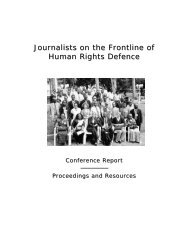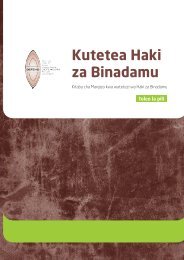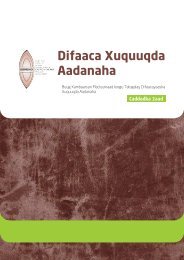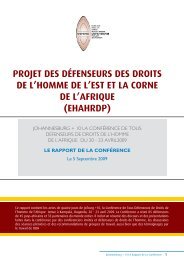Table of Contents - East and Horn of Africa Human Rights ...
Table of Contents - East and Horn of Africa Human Rights ...
Table of Contents - East and Horn of Africa Human Rights ...
Create successful ePaper yourself
Turn your PDF publications into a flip-book with our unique Google optimized e-Paper software.
Regional Workshop on Women <strong>and</strong> Minority <strong>Human</strong> <strong>Rights</strong> Defenders<br />
� It makes (wo)men<br />
� … PRESENT (Citizens)<br />
� … ACTORS (Power)<br />
� … BENEFICIARIES (Accountability)<br />
� Gender Equality means Equality under the law <strong>and</strong> in opportunities including rewards for work<br />
<strong>and</strong> in access to, ownership <strong>of</strong>, <strong>and</strong> decision-making over resources that improve livelihoods<br />
<strong>and</strong> voice to influence <strong>and</strong> contribute to development.<br />
�<br />
� We are trying to achieve substantive equality – through recognizing the historical, present <strong>and</strong><br />
multiple differences among the sexes <strong>and</strong> from that analysis, pursuing measures that provide real<br />
options or create enabling conditions that will correct these differences <strong>and</strong> achieve equality<br />
between men <strong>and</strong> women.<br />
� As such, substantive equality looks at ensuring equal access <strong>and</strong> equal benefits, but recognizes the<br />
need at times for special steps <strong>and</strong> measures to ensure real equality between the sexes.<br />
� To ensure substantive equality, HR Defenders need to look at “how” <strong>and</strong> “why” women <strong>and</strong> men<br />
are treated differently, <strong>and</strong> develop policies/programmes <strong>and</strong> special measures to address this.<br />
� The call for gender mainstreaming dem<strong>and</strong>s that we pay attention to unequal relations <strong>of</strong> power<br />
within all structures <strong>and</strong> organizational frameworks, including our own - <strong>and</strong> addressing it.<br />
� Having those hard <strong>and</strong> tough but fundamental conversations in our ogrnaizations: Who are we?<br />
What do we st<strong>and</strong> for? What does it mean to us to be HR Defenders? HR for who?<br />
� Being aware <strong>of</strong> <strong>and</strong> in tune with risks <strong>and</strong> vulnerabilities that male <strong>and</strong> female human rights<br />
defenders that we employ are susceptible to – in private <strong>and</strong> public realms<br />
� Developing protection mechanisms that are responsive to the threats <strong>and</strong> risks they encounter as<br />
male <strong>and</strong> female human rights defenders (*FIDA)<br />
� Developing programs, activities <strong>and</strong> allocating resources to address wellbeing issues (stress,<br />
trauma, burn out, self esteem, non recognition)<br />
� Documenting the violations <strong>and</strong> abuses in order to dem<strong>and</strong> accountability. Importance <strong>of</strong> naming<br />
the abuse for what it is <strong>and</strong> dem<strong>and</strong>ing that it stops. Ensuring that the documentation captures<br />
experiences <strong>of</strong> both men <strong>and</strong> women HR Defenders<br />
� It means unpacking our work to ensure that we address men’s <strong>and</strong> women’s experiences in the<br />
work we do<br />
� Torture (interpretation <strong>of</strong> DV, FGM)<br />
� Death Penalty<br />
36 | P a g e








